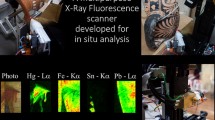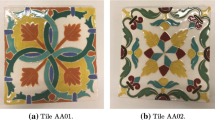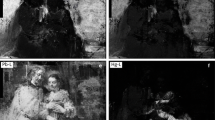Abstract
INFN-CHNet is the cultural heritage network of the Italian National Institute of Nuclear Physics (INFN) and is constituted by units from Italy and from outside Europe, one of them at Universidad Nacional de San Martín (UNSAM) in Buenos Aires, Argentina. As a result of the initiative carried out during 2015 by the Accademia dei Lincei for the year of the Italian culture in Latin America, an INFN-CHNet laboratory was set at CEPyA-UNSAM with the collaboration of INFN and the Restoration Workshop Centro Tarea. Noteworthy, this laboratory is conceived as a multidisciplinary research facility with complementary skills, both scientific and humanistic. In this context, the first instrument jointly set up, optimised, and applied to Cultural Heritage was an X-ray fluorescence scanner. In this manuscript, we describe the instrument and its main features together with a set of representative yet novel applications in the field of cultural heritage, namely, the experimental study of hidden rock art through laboratory replicas that imitates the problems found in the archaeological sites (hematite drawings hidden below carbon deposition); the study and chemical characterisation of archaeological decorated pottery; and finally, the application of the XRF scanner to ancient photography, for quick and accurate identification of materials and techniques employed. Beyond these specific results, the primary output of this initiative has been the conception of a future network of scientific laboratories in South America, coordinated by CEPyA at UNSAM.





Similar content being viewed by others
Data availability
The datasets generated during and/or analysed during the current study are available from the corresponding author on reasonable request.
References
Albertin F, Ruberto C, Cucci C et al (2021) “Ecce Homo” by Antonello da Messina, from non-invasive investigations to data fusion and dissemination. Sci Rep 11:1–18. https://doi.org/10.1038/s41598-021-95212-2
Anglos D, Miller JC, Melesanaki K et al (2002) Laser-induced breakdown spectroscopy for the analysis of 150-Year-Old daguerreotypes. Appl Spectrosc 56:423–432
Bonneau A, Pearce DG, Pollard AM (2012) A multi-technique characterization and provenance study of the pigments used in San rock art. South Africa. https://doi.org/10.1016/j.jas.2011.09.011
Castellá F, Pérez-Estebanez M, Mazurek J et al (2020) A multi-analytical approach for the characterization of modern white paints used for Argentine concrete art paintings during 1940–1960. Talanta. https://doi.org/10.1016/J.TALANTA.2019.120472
De La Fuente GA, Kristcautzky N, Toselli G, Riveros A (2005) Petrología cerámica comparativa y análisis composicional de las pinturas por MEB-EDS de estilo Aguada Portezuelo (ca. 600–900 DC) en el valle de Catamarca (Noroeste Argentino). Estud Atacameños 30:61–78
De la Fuente G, Pérez Martínez JM (2018) Ancient potters, paintings and craft specialization in northwestern argentine region: new data through Raman characterization of preand postfiring ceramic paintings on Aguada Portezuelo Ceramics from Middle Period (Catamarca, Argentina). Archaeol Anthopological Sci 11:2293–2308
Feigerle CS, Hogan DL, Romer G et al (1999) Laser ablation mass spectroscopy of nineteenth century daguerreotypes. Appl Spectrosc 53:1161–1168
Gasanova S, Hermon S (2017) Micro-XRF complemented by x-radiography and digital microscopy imaging for the study of hidden paintings. Opt Arts, Archit Archaeol VI 10331:103310T. https://doi.org/10.1117/12.2270085
Gheco LI, Quesada MN, Ybarra G et al (2013) Espacios rupestres como «obras abiertas»: una mirada a los procesos de confección y transformación de los abrigos con arte rupestre del este de Catamarca (Argentina). Rev Española Antropol Am. https://doi.org/10.5209/rev_REAA.2013.v43.n2.44014
Gheco L, Gastaldi M, Marte F et al (2017) About fires and paintings: three stratigraphic insights on the history of a cave with prehispanic rock art. J Archaeol Sci Reports 15:48–58. https://doi.org/10.1016/j.jasrep.2017.07.009
Gheco L, Gastaldi M, Mastrangelo N et al (2019a) Entre humos, fuegos y pinturas. Una metodología para conectar historias sobre una cueva con arte rupestre del sitio de Oyola (Catamarca, Argentina). Boletín Del Mus Chil Arte Precolomb 24:131–152
Gheco L, Tascon M, Gastaldi M et al (2019b) Hidden paintings. forgotten histories: a micro-stratigraphic approach to study coated rock art. Archaeol Anthropol Sci 11:5037–5052
Giuntini L, Castelli L, Massi M et al (2021) Detectors and cultural heritage: the INFN-CHNet experience. Appl Sci 11:1–56. https://doi.org/10.3390/app11083462
Keyence (2018) https://www.keyence.com/products/sensor/positioning/ia/models/ia-100/
Kozachuk MS, Sham TK, Martin RR et al (2018) Exploring tarnished daguerreotypes with synchrotron light: XRF and μ-XANES analysis. Herit Sci 6:1–12. https://doi.org/10.1186/s40494-018-0171-8
Lazic V, Vadrucci M, Fantoni R et al (2018) Applications of laser induced breakdown spectroscopy for cultural heritage: a comparison with XRF and PIXE techniques. Spectrochim Acta - Part B at Spectrosc 149:1–14. https://doi.org/10.1016/j.sab.2018.07.012
Macková A, Macgregor D, Azaiez F, et al (2016) Nuclear physics for cultural heritage, EPSNPD
Mazzinghi A, Ruberto C, Castelli L et al (2021a) Ma-xrf for the characterisation of the painting materials and technique of the entombment of christ by rogier van der weyden. Appl Sci. https://doi.org/10.3390/app11136151
Mazzinghi A, Ruberto C, Castelli L et al (2021b) The importance of being little: MA-XRF on manuscripts on a venetian island. X-Ray Spectrom 50:272–278. https://doi.org/10.1002/xrs.3181
Modica A, Alberghina MF, Brai M et al (2017) XRF analysis to identify historical photographic processes: the case of some Interguglielmi Jr’.s images from the Palermo municipal archive. Radiat Phys Chem 135:76–80. https://doi.org/10.1016/j.radphyschem.2017.02.026
MOXTEK (2018) http://moxtek.com/wp-content/uploads/pdfs/TUB-DATA-1001-TUB00046-Rev-C.pdf
Quesada M, Gheco L (2015) Tiempos, cuevas y pinturas. reflexiones sobre la policronía del arte rupestre de oyola (provincia de catamarca, argentina). Relac la Soc Argentina Antropol 455–476
Ruberto C, Mazzinghi A, Massi M et al (2016) Imaging study of Raffaello’s “La Muta” by a portable XRF spectrometer. Microchem J 126:63–69. https://doi.org/10.1016/j.microc.2015.11.037
Shugar AN, Mass JL (2015) Handheld XRF for Art and Archaeology. Leuven Uni, Leuven
Sottili L, Guidorzi L, Mazzinghi A et al (2021) The importance of being versatile: Infn-chnet ma-xrf scanner on furniture at the ccr “la venaria reale.” Appl Sci 11:1–13. https://doi.org/10.3390/app11031197
Striova J, Ruberto C, Barucci M et al (2018) Spectral imaging and archival data in analysing madonna of the rabbit paintings by manet and titian. Angew Chemie - Int Ed 57:7408–7412. https://doi.org/10.1002/anie.201800624
Stulik D, Kaplan A, Khanjian H (2013) The first scientific investigation of Niépce’s images from UK and US collections: Image layer and image formation. Imaging Sci J 61:602–628. https://doi.org/10.1179/1743131X12Y.0000000007
Stulik DC, Kaplan A (2008) A new scientific methodology for provenancing and authentication of 20th century photographs: nondestructive approach. Int Conf NDT Art 1–11
Taccetti F, Castelli L, Czelusniak C et al (2019) A multipurpose X-ray fluorescence scanner developed for in situ analysis. Rend Fis Acc Lincei. https://doi.org/10.1007/s12210-018-0756-x
Tascon M, Mastrangelo N, Gheco L et al (2016) Micro-spectroscopic analysis of pigments and carbonization layers on prehispanic rock art at the Oyola’s caves, Argentina, using a stratigraphic approach. Microchem J 129:297–304. https://doi.org/10.1016/j.microc.2016.07.003
Acknowledgements
MT, LG, FM, DG, NM and FC are grateful to CONICET, ANPCyT (PICT 2017-1253) and UNSAM for the funding and support provided.
Funding
Fondo para la Investigación Científica y Tecnológica, 2017-1253.
Author information
Authors and Affiliations
Corresponding authors
Ethics declarations
Ethical approval
The authors have declared no conflict of interests.
Additional information
Publisher's Note
Springer Nature remains neutral with regard to jurisdictional claims in published maps and institutional affiliations.
Rights and permissions
Springer Nature or its licensor (e.g. a society or other partner) holds exclusive rights to this article under a publishing agreement with the author(s) or other rightsholder(s); author self-archiving of the accepted manuscript version of this article is solely governed by the terms of such publishing agreement and applicable law.
About this article
Cite this article
Taccetti, F., Castelli, L., Czelusniak, C. et al. Novel implementation of the INFN-CHNet X-ray fluorescence scanner for the study of ancient photographs, archaeological pottery, and rock art. Rend. Fis. Acc. Lincei 34, 515–522 (2023). https://doi.org/10.1007/s12210-023-01143-7
Received:
Accepted:
Published:
Issue Date:
DOI: https://doi.org/10.1007/s12210-023-01143-7




